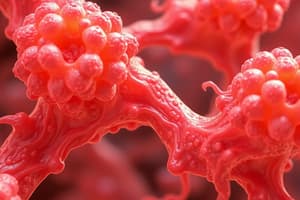Podcast
Questions and Answers
How are functional exocrine glands classified?
How are functional exocrine glands classified?
On how their secretions are released.
What are the three types of functional exocrine glands?
What are the three types of functional exocrine glands?
Merocrine, apocrine, holocrine.
What do each of these secretory processes begin with, and what does it form, and what does it contain?
What do each of these secretory processes begin with, and what does it form, and what does it contain?
Begins with the endoplasmic reticulum and the Golgi complex, forming an intracellular secretory vesicle containing the secretory product.
Where are merocrine glands synthesized, and how is it secreted?
Where are merocrine glands synthesized, and how is it secreted?
What type of glands are most of the exocrine glands of the body?
What type of glands are most of the exocrine glands of the body?
What are three examples of merocrine glands?
What are three examples of merocrine glands?
Where do secretions of apocrine glands come from, and how is it secreted?
Where do secretions of apocrine glands come from, and how is it secreted?
What are two examples of apocrine glands?
What are two examples of apocrine glands?
Where do secretions of holocrine glands come from, and how is it secreted?
Where do secretions of holocrine glands come from, and how is it secreted?
What is contained in the secretion of holocrine glands?
What is contained in the secretion of holocrine glands?
What do holocrine glands require a lot of?
What do holocrine glands require a lot of?
What are two examples of holocrine glands?
What are two examples of holocrine glands?
Flashcards
Exocrine Gland Classification
Exocrine Gland Classification
Classified based on how they release their secretions.
Three Exocrine Gland Types
Three Exocrine Gland Types
Merocrine, apocrine, and holocrine.
Secretory Process Start
Secretory Process Start
Begins with the endoplasmic reticulum and Golgi complex, forming an intracellular secretory vesicle containing the secretory product.
Merocrine Secretion
Merocrine Secretion
Signup and view all the flashcards
Prevalence of Merocrine Glands
Prevalence of Merocrine Glands
Signup and view all the flashcards
Examples of Merocrine Glands
Examples of Merocrine Glands
Signup and view all the flashcards
Apocrine Secretion
Apocrine Secretion
Signup and view all the flashcards
Examples of Apocrine Glands
Examples of Apocrine Glands
Signup and view all the flashcards
Holocrine Secretion
Holocrine Secretion
Signup and view all the flashcards
Holocrine Secretion Contents
Holocrine Secretion Contents
Signup and view all the flashcards
Holocrine Gland Requirement
Holocrine Gland Requirement
Signup and view all the flashcards
Examples of Holocrine Glands
Examples of Holocrine Glands
Signup and view all the flashcards
Study Notes
Functional Classification of Exocrine Glands
- Exocrine glands are classified based on their secretion mechanisms.
- Three primary types of functional exocrine glands:
- Merocrine
- Apocrine
- Holocrine
Secretory Processes
- All secretory processes initiate in the endoplasmic reticulum and golgi complex.
- These organelles collaborate to form intracellular secretory vesicles that contain the secretory product.
Merocrine Glands
- Synthesized on ribosomes attached to rough endoplasmic reticulum (ER).
- Processed and packaged by the golgi complex.
- Secretions released from the cell via exocytosis in secretory vesicles.
- Represent the majority of exocrine glands in the body.
- Examples include:
- Salivary glands
- Pancreas
- Some sweat glands
Apocrine Glands
- Secretions accumulate at the apical surface of the cell.
- The apical portion pinches off through exocytosis to release the secretion.
- The cell repairs itself and can repeat the process.
- Examples include:
- Mammary glands
- Sweat glands located in armpits and groin
Holocrine Glands
- Secretions build up in the cytosol as cells mature.
- The entire cell ruptures to release its contents as the secretory product.
- Newly formed cells replace those that are destroyed.
- Secretes large amounts of lipids from plasma and intracellular membranes.
- Require significant cell divisions for replacement.
- Examples include:
- Sebaceous glands of the skin
- Associated with acne production
Studying That Suits You
Use AI to generate personalized quizzes and flashcards to suit your learning preferences.




